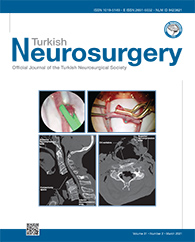2Health Sciences University, Erzurum Regional Training and Research Hospital, Department of Neurosurgery, Erzurum, Turkey DOI : 10.5137/1019-5149.JTN.29765-20.2 AIM: To compare the clinical and radiological results of using synthetic bone graft versus autograft obtained from the spinous process in posterior lumbar interbody fusion.
MATERIAL and METHODS: This retrospective study included 102 patients with degenerative lumbar spondylolisthesis who underwent one-segment posterior lumbar interbody fusion (PLIF) followed by one-segment posterior transpedicular instrumentation. PLIF surgery was performed using a local solid bone graft obtained from the spinous process in group A and using a synthetic solid calcium hydroxyapatite block in group B. The Oswestry Disability Index (ODI), visual analogue scale (VAS) scores, degree of bone formation, intervertebral disc heights at the operation segment, wound infection, and instrumentation complications were compared between the 6-month and 5-year follow-ups.
RESULTS: In both groups, ODI and VAS scores significantly improved at the 6-month and 5-year follow-up. Bone formation at both 6 months and 5 years were higher in group A than that in group B, but without a significant difference when compared. Moreover, the difference in maintaining the intervertebral disc heights was not significant between the two groups. Surgical wound infection more commonly occurred in group B, but without significant difference between the two groups, and rod fractures were observed in two patients in group B; however, no metal breakage was observed in group A.
CONCLUSION: Successful fusion of the intervertebral space and intervertebral height restoration can be achieved and maintained with an autograft from the patient?s spinous processes.
Keywords : Lumbar spondylolisthesis, Spinous process, Autograft, PLIF




